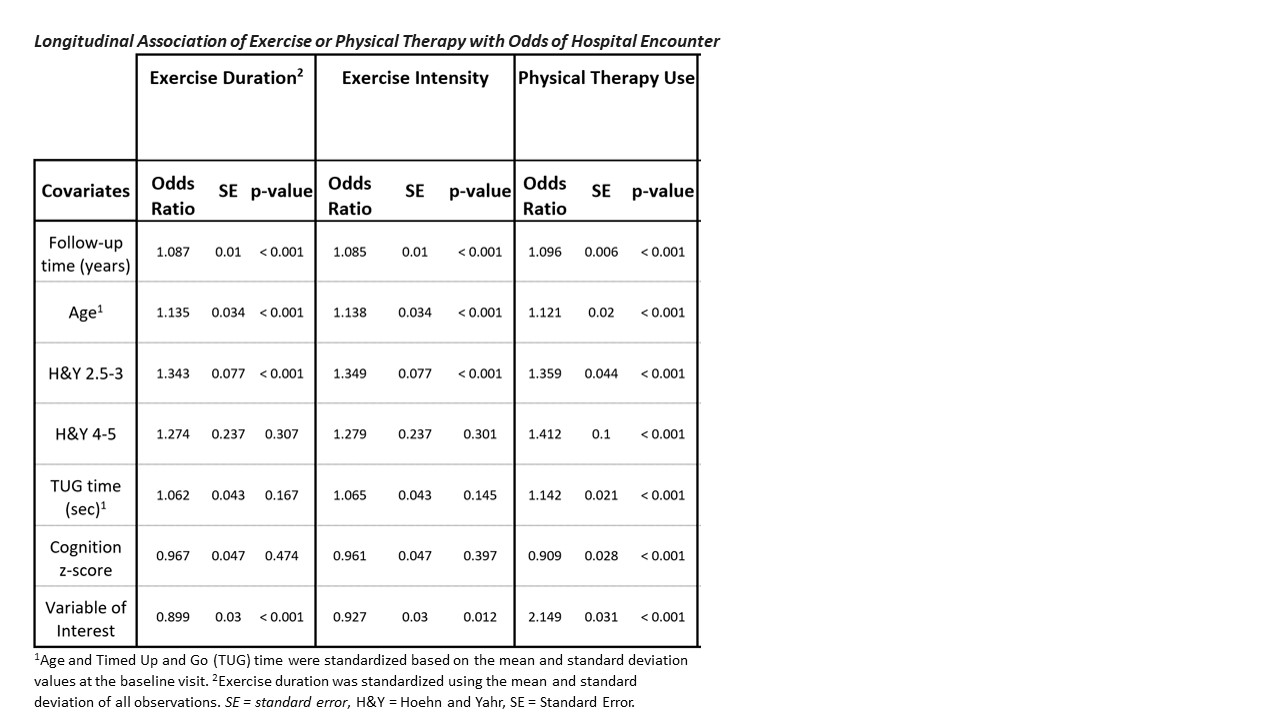Objective: To determine if longitudinal exercise and physical therapy (PT) use is associated with reduced risk of hospital encounter in individuals with Parkinson’s disease (iwPD).
Background: In iwPD, exercise and PT use has been associated with improved mobility, reduced mortality, and potentially reduced disease progression [1]. Despite these known benefits, few studies have assessed the role of exercise and PT in mitigating risk of hospitalization in iwPD, which is increased and prolonged in this population [2]. Targeted interventions to reduce hospitalization in iwPD can increase quality of life and reduce healthcare costs.
Method: Using exercise and PT use data of over 4500 and 9000 individuals, respectively, from the Parkinson Foundation Parkinson’s Outcome Project, longitudinal regression, bivariate, and chi-square analyses were performed to determine the longitudinal and temporal association of exercise and PT use with risk of hospital encounter, either an emergency room visit or a hospital admission.
Results: Greater longitudinal exercise duration or intensity was associated with decreased odds of hospital encounter when controlling for age, disease stage, cognition, and mobility. Reductions in exercise duration/intensity did not occur more frequently within two study visits prior to a hospital encounter. Conversely, greater longitudinal PT use was associated with increased risk of hospital encounter and PT referral was more frequent at the study visit prior to a hospital encounter (Table).
Conclusion: Reduced odds of hospital encounter with greater longitudinal exercise duration/intensity fits with the multiple known benefits of exercise in iwPD. The protective effect of exercise against hospitalization was not decreased by temporally proximate reductions in exercise suggesting long-term benefit. PT referral may serve as marker of iwPD at risk for hospitalization given its temporal and longitudinal association with hospitalization despite known disease-specific benefits. Better understanding of characteristics that lead to PT referral and developing programs that incentivize consistent longitudinal exercise may reduce risk of hospitalization in iwPD.
References: 1. Rafferty, M. R. et al. Regular Exercise, Quality of Life, and Mobility in Parkinson’s Disease: A Longitudinal Analysis of National Parkinson Foundation Quality Improvement Initiative Data. J. Park. Dis. 7, 193–202 (2017).
2. Guttman, M., Slaughter, P. M., Theriault, M.-E., DeBoer, D. P. & Naylor, C. D. Burden of parkinsonism: a population-based study. Mov. Disord. Off. J. Mov. Disord. Soc. 18, 313–319 (2003).
To cite this abstract in AMA style:
G. Kannarkat, M. Rafferty, S. Luo, H. Liu, K. Mills. Longitudinal Exercise is Associated with Reduced Hospitalization Risk in Parkinson’s Disease [abstract]. Mov Disord. 2022; 37 (suppl 2). https://www.mdsabstracts.org/abstract/longitudinal-exercise-is-associated-with-reduced-hospitalization-risk-in-parkinsons-disease/. Accessed December 30, 2025.« Back to 2022 International Congress
MDS Abstracts - https://www.mdsabstracts.org/abstract/longitudinal-exercise-is-associated-with-reduced-hospitalization-risk-in-parkinsons-disease/

